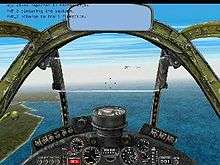Air Warrior
| Air Warrior II | |
|---|---|
 | |
| Developer(s) | Kesmai |
| Publisher(s) |
Konami (Air Warrior SVGA) |
| Platform(s) | Windows, 3DO |
| Release date(s) |
Air Warrior II - 1997 Air Warrior - 1995 |
| Genre(s) | Combat flight simulator |
| Mode(s) | Single-player, multiplayer |
Air Warrior was a multiplayer on-line air-combat simulator launched by Kesmai in 1988. It was hosted on GEnie and used that service as a server for client software running on a variety of personal computers available in that era. It underwent continual improvement through its decade-long lifetime with Kesmi, appearing on new platforms and host services. Electronic Arts purchased Air Warrior in 1999, and became provider of the game, but it was discontinued in 2001.
Air Warrior was one of the first massive online games, hosting hundreds of users during busy periods. It inspired WarBirds, which in turn inspired to Aces High. Today there are a number of similar games, like WarThunder, most of them based on a freemium model.
Description
Introduced in 1988 by Kesmai,[1] Air Warrior was played over modems and hosted on the GEnie online service provider. Players could choose one of a number of World War II aircraft to fly, along with ground vehicles, and play in a multiplayer "arena" with hundreds of other players. The game focussed mostly on dogfighting, with a secondary strategic role of capturing forward airbases near the center of the map. Several updated versions were released, and additional service providers were added over time.
The original version of Air Warrior ran on Apple Macintosh, Commodore Amiga, and Atari ST computers, had simple black and white wireframe graphics, and cost over $10 per hour to play. Over time, Kesmai produced improved versions of the game, starting with SVGA Air Warrior (AWSVGA) in 1993, and continuing with Air Warrior for Windows (AW4W) in 1996, Air Warrior II (AWII) in early 1997, Air Warrior III (AWIII) later in 1997, and finally Air Warrior III Millennium Version (AW:MV) in 2000.
Kesmai also did business deals to provide access to Air Warrior through additional on-line services, including Delphi, CRIS, CompuServe, America Online, Earthlink, Gamestorm and CompuLink. A version of Air Warrior for Windows was ported back to the Macintosh in 1997 in an Internet open beta, and then later moved to America Online. In 1999, Electronic Arts purchased Air Warrior, and became provider of the latest version of the game, only to discontinue it in 2001.
Reception
Computer Gaming World in 1990 called Air Warrior "the most exciting [wargame] I've played", warning players to "be resigned to spending some money on it, though, because time flies while you do".[2] 1991 and 1993 surveys in the magazine of strategy and war games gave it three and a half stars out of five.[3][4] The magazine in 1993 praised the flight models' accuracy, stating that it forced pilots to choose correctly when selecting aircraft to fly against other humans. The magazine suggested that if Kesmai were to add some upgrades to the offline single-player mode it would "blow away any of the competition".[5]
Air Warrior III
| Air Warrior III | |
|---|---|
 | |
| Developer(s) | Kesmai |
| Publisher(s) | I-Magic |
| Platform(s) | Windows |
| Release date(s) | 30 November, 1997 |
| Genre(s) | Combat flight simulator |
| Mode(s) | Single-player, multiplayer |

Air Warrior III had as one playing area a map of northern Europe, besides many small playing fields with some real-life features labeled. Berlin, the Kiel Canal, and Peenemünde were unmarked in the game. There was also a playing area map that included a hodgepodge of Pacific islands and the coast of Australia. The player could design his own missions on any of these playing fields. Fans of the on-line competition developed a tool that enabled the player to paint his or her own aircraft. Screenshots could be taken in combat, and even videos, which could be distributed over the Internet. Douglas C-47s could be used to carry paratroops to take enemy air bases.
There were many ships and a few buildings to attack, including V-2s at Peenemünde, a bridge near Westminster's Parliament House, and the Brandenburg Gate of Berlin. However, targets that were destroyed soon re-appeared. Besides aircraft, the player could control a jeep, a tank, a truck, or a flak panzer. The player could also drive through the fence surrounding after destroying it with a tank. The aircraft carriers and other ships were fixed at their places.
References
- ↑ Brooks, M. Evan (2001)
- ↑ Archibald, Dale (January 1990). "Lost in the Ozone Again / "Air Warrior" on GEnie". Computer Gaming World. p. 14. Retrieved 15 November 2013.
- ↑ Brooks, M. Evan (November 1991). "Computer Strategy and Wargames: The 1900-1950 Epoch / Part I (A-L) of an Annotated Paiktography". Computer Gaming World. p. 138. Retrieved 18 November 2013.
- ↑ Brooks, M. Evan (September 1993). "Brooks' Book of Wargames: 1900-1950, A-P". Computer Gaming World. p. 118. Retrieved 30 July 2014.
- ↑ Fick, Doug (May 1993). "SVGA Air Warrior". Computer Gaming World. p. 98. Retrieved 7 July 2014.
Sources
- Anderson, Brooke P. (1997). How to Fly and Fight in Air Warrior, Appendix: History of Air Warrior.
- Air Warrior II at MobyGames
- Brooks, M. Evan (2001). dates of release for some versions of Air Warrior.
- Book of MacDweeb, 1999. satirical history of Air Warrior for Macintosh in the spirit of the Wingless Cafe.
External links
- Air Warrior series at MobyGames
- The MS-DOS version of Air Warrior can be played for free in the browser at the Internet Archive